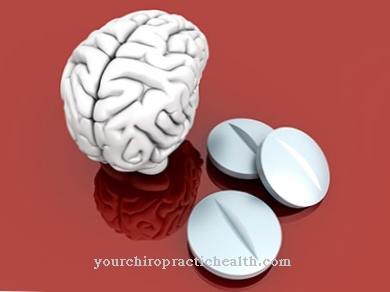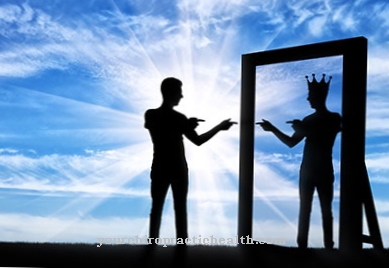If suddenly unbearable pain in the flank area occurs, a renal colic be thought. The symptoms are caused by a blockage of the ureter with a urinary stone. The doctor can prescribe effective painkillers, monitor the course of renal colic and, if necessary, intervene surgically.
What is renal colic?

© Crystal light - stock.adobe.com
A renal colic describes an acute pain condition that is usually unbearable for the person concerned and occurs in bursts. The pain begins in one of the flanks and extends to the side of the abdomen and the genitals.
In addition, the pain can lead to vomiting and profuse sweating. Renal colic is triggered by a large urinary stone from the renal pelvis that suddenly blocks the ureter on its way to the bladder.
As a result, the muscles surrounding it continuously contract to loosen the stone and transport it to the bladder. The increasing cramping of the muscles leads to the typical wave-like pain of renal colic.
causes
Cause one renal colic is a blockage of the ureter by a urinary stone. Frequently, the affected person has several stones in the renal pelvis, which, regardless of the spontaneous colic, give him dull pain in the flank.
Smaller stones can usually pass the ureter without problems. Urinary stones are more common in people with frequent urinary tract infections. Sufficient fluid intake is therefore important on the one hand in order to avoid infections and also to counteract the formation of urinary stones.
Urinary stones can also develop after weight loss and the associated change in diet. Constrictions and malformations of the ureter are also more likely to cause urinary congestion and the formation of urinary stones as a result. Renal colic may therefore occur more frequently in these patients.
Symptoms, ailments & signs
One-sided, severe to unbearable pain is characteristic of renal colic. It begins acutely on the affected kidney, i.e. in the back at the level of the short ribs. The strength depends on the shape and size of the kidney stone causing it and the condition of the ureter. The pain can radiate to the whole back or to the front of the chest and abdomen.
If a kidney stone is stuck in the ureter, the pain stays in one place and can increase and decrease in stages. If the stone moves through the ureter towards the bladder, then the point from which the pain radiates slowly moves down into the back of the abdomen and finally diagonally towards the middle of the body. Bloody urine is possible, but not all of those affected.
The pain can end suddenly if the kidney stone enters the urinary bladder. When urinating, the stone can now get into the urethra. This causes the pain to come back, this time in the center of the pelvis. Acute pain travels down the urethra until the stone gets outside. Some patients report hearing the excreted kidney stone fall into the toilet.
Diagnosis & course
The diagnosis of renal colic is usually suspected by the doctor based on the typical pain along the patient's flank. They are often so unbearable for the patient that they see the doctor immediately or call the emergency service. A laboratory test of the urine serves to rule out infections of the urinary bladder or kidneys.
If the patient has chills or a fever, an additional kidney infection should also be considered. The urinary stones that cause renal colic can be visualized by an ultrasound examination or an X-ray examination with a contrast agent. Computed tomography (CT) is rarely necessary.
When should you go to the doctor?
If you notice sharp pain, nausea and vomiting, or signs of an obstructed bowel, a doctor is recommended. If the symptoms do not go away on their own, they must be clarified by a doctor, as there may be a serious cause such as renal colic. A reduced amount of urine and swelling in the kidney area also indicate a medical emergency. Affected people should be taken to hospital or the emergency services must be called in the event of severe complaints. If there is already a specific suspicion that the symptoms could be caused by renal colic, the family doctor must be consulted immediately.
Corresponding complaints must definitely be clarified if they occur in connection with a urinary stone disease or an acute urinary flow disorder. The same applies if renal colic occurs in connection with a diagnosed tumor disease in the area of the ureter or kidney, blood clots or diseases of the connective tissue. Renal colic is treated by a nephrologist or a gastroenterologist. In the event of a medical emergency, the sick person must be treated as an inpatient in the hospital. During drug treatment, careful attention must be paid to any side effects caused by the prescribed drugs and these must be reported to the doctor in order to rule out further complications.
Treatment & Therapy
Treatment of the renal colic should first relieve the patient's severe pain with pain relievers. These are usually taken every two to three hours. Stones up to five millimeters in size should detach themselves from the ureter and move further into the bladder.
The patient has to drink a lot and exercise enough to stimulate the further transport of the stone. Up to 80 percent of urinary stones disappear in this way without surgical therapy. However, if renal colic occurs again or if the urinary stone is larger, shock wave lithotripsy (ESWL) can be performed under local anesthesia.
The stones are destroyed by shock waves generated outside of the body and the fragments can then easily pass through the ureter. Large urinary stones and especially those that fill the renal pelvis can also be removed endoscopically through the skin of the abdomen from the renal pelvis with so-called percutaneous nephrolithoplaxis (PNL).
A combination of both methods is also possible. Ureterorenoscopy may also be performed in patients with large urinary stones leading to recurrent renal colic with excruciating pain if all other measures do not provide relief. During this surgical procedure, the stones, and thus the triggers of renal colic, are removed endoscopically through the urethra.
Complications
Renal colic is always an emergency and should be treated as soon as possible. It is true that the kidney stone that is causing it often resolves on its own with the help of fluid, exercise and medical treatment. However, it can happen that the stone gets stuck and leads to dangerous urinary retention. If this urinary congestion is not treated, severe kidney damage occurs, which can lead to the complete destruction of the kidneys.
After an acute urinary congestion, however, the functionality of the kidneys can be fully restored with immediate treatment. If the symptoms of renal colic are ignored, however, chronic urinary obstruction can occur, in which the urine flow is only partially guaranteed. As a result, a sack-shaped expansion of the kidney cavity often forms.
This leads to the destruction of functional kidney tissue with the development of a so-called shrink kidney. In the event of a urine outflow problem, an infection of the lower urinary tract can also occur. Under certain circumstances, this then leads to a septic urinary stasis kidney, which is associated with severe fever, chills, severe pain and pelvic inflammation. If left untreated, the congestive kidney can lead to death. This is especially the case when the bacteria are washed into the bloodstream and cause blood poisoning there.
Outlook & forecast
Renal colic is an acute state of health that requires immediate action. Without the fastest possible medical care, the person concerned is at risk of irreversible organ damage and life-threatening conditions. The sooner the medical emergency is treated professionally, the better the further course of the disease and thus the prognosis.
Under optimal conditions, in addition to the supply of fluids, drug treatment is initiated and special exercise therapy is carried out. These measures can already lead to a significant alleviation of the symptoms and in the further course lead to freedom from symptoms. If there are no complications or permanent tissue damage to the kidneys, the patient can be discharged from treatment after a few weeks as recovered.
In most cases, despite all efforts, the kidneys can no longer function properly. Long-term therapy may be necessary. In addition to drug treatment, dialysis is another possible health measure to improve the overall situation.
This represents a special challenge for coping with the everyday life of the person affected. The emotional stresses are often so strong that psychological secondary diseases occur. This must be taken into account when making the forecast. In some patients, the last treatment option remains a transplant. Otherwise, the average life expectancy will be significantly reduced, as there is a risk of organ failure.
prevention
One renal colic can be prevented with adequate hydration. This is particularly important in summer temperatures and the associated increased sweating. Frequent urinary tract infections, which also favor the formation of urinary stones, can also be prevented. The rapid loss of body weight without sufficient drinking also promotes the development of urinary stones and thus the occurrence of renal colic.
Aftercare
After treatment of renal colic, follow-up care is indicated in order to alleviate any symptoms in a targeted manner and to monitor the progression of the disease beyond recovery. The risk of complications varies depending on the type and severity of the colic. Metaphylaxis is necessary in any case, as otherwise kidney damage can go unnoticed or renal colic develops again and further damages the organ.
The first follow-up examination consists primarily of an inspection of the affected kidney. To do this, the doctor uses imaging techniques and a physical examination. The anamnesis is used to answer open questions and to clarify any complaints. If no abnormalities are found, follow-up care can be completed. Renal colic should not cause any further symptoms once it has subsided.
It is sufficient for the patient to take advantage of the normal preventive examinations. In addition, you must continue to watch for signs of recurring kidney problems. Medicinal treatment for pain or persistent inflammation can be monitored by your family doctor. Finding the cause of renal colic can also be part of the follow-up, provided that the trigger was not determined during the actual treatment.
You can do that yourself
In order to support the natural removal of the urinary stone, the person affected should exercise enough. Regular sporting activities and targeted movements of the pelvis can lead to a spontaneous detachment of the foreign body. This avoids surgery and reduces the need for medical treatments. At the same time, a warning should be given against overexertion or overloading of the organism, otherwise the general condition will deteriorate.
As soon as the urinary stone is completely removed, spontaneous healing occurs and the patient is usually symptom-free. Various measures can also be taken to minimize the long-term risk of renal colic. The change in diet can counteract the formation of new urinary stones. The consumption of meat and offal should be reduced or avoided. The consumption of the luxury food coffee should also be restricted in order to improve health. In addition, you should refrain from drinking black tea and consuming dairy products.
A healthy and balanced diet as well as regular exercise promotes the long-term maintenance of health. The intake of two liters of liquid per day is recommended for adults. If you have renal colic, the amount of fluid you drink should be increased. This stimulates the kidneys and increases the likelihood of the foreign body being removed naturally.


.jpg)


.jpg)
.jpg)

















.jpg)



